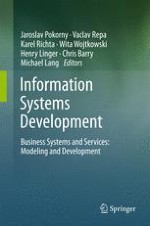2011 | OriginalPaper | Chapter
A Requirements Engineering Approach to Improving IT-business Alignment
Authors : Azmat Ullah, Richard Lai
Published in: Information Systems Development
Publisher: Springer New York
Activate our intelligent search to find suitable subject content or patents.
Select sections of text to find matching patents with Artificial Intelligence. powered by
Select sections of text to find additional relevant content using AI-assisted search. powered by
